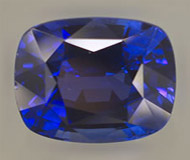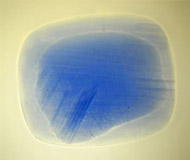| |
|
|
|
|
|
|
Treated
Blue Sapphires from Sri Lanka |
|
Note:
On April 14, 2004, the GIA announced that they could
find no evidence of diffusion treatment with these stones
and would simply describe the stones as: “NATURAL SAPPHIRE,
Comments: Evidence of heat treatment is present.”
January
16, 2004 – The International Colored Gemstone Association
(ICA) has just issued an ICA Lab Alert summarizing the
latest gemological findings regarding suspicious treated
blue sapphires from Sri Lanka. Gemologists at two of
the world’s premier gemological labs have independently
studied these blue sapphires with unusual colorless
rims. One lab has cleared these stones, but others believe
still more study needs to be done before a definitive
conclusion can be reached.
These suspect blues first came
to the attention of gemologists when the American Gem
Trade Association (AGTA) lab’s director, Kenneth Scarratt,
noticed the suspicious color pattern on a stone submitted
for testing in December, 2002. Following closely on
the heels of the beryllium diffusion controversy (see
‘The Skin Game’ by R.W. Hughes), this immediately raised
concerns. Scarratt quietly informed other gemologists
of what he had found, seeking their opinions/advice. |
| |
 |
| |
Following
these discussions, three different theories
developed:
- These light rims
represented synthetic corundum overgrowths
on natural cores, probably developed
during high-temperature heat treatment,
where the skins of crystals or cut stones
were dissolved and molten corundum was
redeposited.
- These light rims
represented outside-in diffusion of
color bleaching agents such as beryllium,
magnesium or lithium during the heating
process. Evidence of this is suggested
by the surface-conformal nature of many
(but not all) of these lighter rims.
- These light rims
occurred due to compositional differences
existing in the original crystals, highlighted
by application of high-temperature heat
treatment.
We all know that
composition/conditions often change
during a crystal's growth and this is
often evidenced by changes in color
zoning, inclusions, etc. A classic example
of this is the ottu sapphires
of Sri Lanka, which feature blue skins
covering near-colorless cores. Thus
it is possible that these rims simply
reflect underlying compositional/structural
differences present in the original
crystals. Such features might be difficult
to see in the untreated stone, but could
became manifest following a unique treatment
regimen.
Of course, this begged the question why
such features were not found before, with
sapphires having been cooked at high temperatures
for close to three decades? Would a variation
of heating time and temperature be sufficient
to produce such unusual features? Or had
we been seeing such features all along,
but simply ignoring them? Is the reason
they now attract attention because the recent
beryllium business has gemologists wielding
their weapons with hair triggers, ready
to blast away at the slightest movement
in the bushes?
These were the questions gemologists sought
to put to rest. Slowly more stones with
these suspicious rims came to light, to
the point where it was felt that traders
had to be warned. Meetings were held, information
was exchanged, inventories were checked,
the latter revealing a surprising number
of such stones. All appeared to be of Sri
Lankan origin, and most were larger than
five carat |
|
|
This
5.94-ct. Sri Lankan sapphire is an example of
the type recently suspected of being treated by
a new process. Photo: Wimon Manorotkul |
| |
 |
|
The
same stone viewed in immersion in di-iodomethane.
A near-colorless rim can clearly be seen. While
it was originally suspected that this rim might
result from some sort of dissolution and regrowth
during heating, it now appears that this can be
ruled out. The origin of these color rims is still
the subject of much speculation. Photo: Richard
Hughes |
|
|
Eventually, many stones
were traced back to the ovens of Punsiri Tennakoon of
Punsiri Gems in Sri Lanka. He was contacted and held
a number of candid discussions with both AGTA and GIA
gemologists. Out of these discussions came a December
2003 visit by Christopher P.
Smith and Matthew Hall of the Gemological Institute of America (GIA)
to witness first-hand Punsiri Tennakoon’s heating methodology.
Following a number of experiments,
they were able to entirely rule out the possibility
of a synthetic overgrowth. Smith and Hall also concluded
that there appeared to be no evidence that the colorless
rims were the result of a beryllium bulk (lattice) diffusion
treatment. The GIA stressed
that this conclusion is preliminary, and more study
is planned. Their report concluded:
At present, we cannot state conclusively
the role that lattice diffusion plays in this peculiar
color phenomenon or which elements may be involved.
However, we are continuing our research into the exact
mechanisms responsible for these unusual color concentrations,
and will release our findings to the trade as they become
available.
Henry
Hänni of the Swiss Gemmological Institute (SSEF) has
also studied these stones and in the ICA Lab Alert was
quoted as suggesting that the white rims result from
a defect in the heating process where oxygen accidentally
enters the furnace chamber during the final stages of
heating, thus decolorizing the rims of the stones. In
the light of the above explanation, SSEF said that it
would describe the stones it tested as “heated” when
issuing its laboratory test reports. “We do not see
evidence of diffusion of a foreign element, as in the
case of the beryllium treated orange and yellow sapphires,”
SSEF declared.
Others have suggested that a defective heating process
is probably not the case, that to bleach color from
the rim, something would have to be diffused in. According
to current knowledge, hydrogen would diffuse in far
too fast for the above scenario and oxygen far too slow.
That’s the theory, anyway, but as we learned from the
beryllium business, theories will need to be tested
by rigorous experiments.
Thus it is clear that more work remains before a definitive
answer can be given. But without question, the recent
cooperation between Punsiri Tennakoon and the world
gemological community is an example of the right way
to solve a serious problem (in contrast to the earlier
beryllium fiasco, where burners in Thailand tried to
hide what they were doing, with disastrous consequences
for that nation’s entire gem industry).
In the current case, the outcome is looking far better.
Perhaps these blues will eventually come in from the
cold. This would be a plus for all parties, but particularly
for the science of gemology, showing as it does that
gemologists are not “out to get” anything except the
truth. |
|
|
|
|
|
|
|
|
|
|
|
|